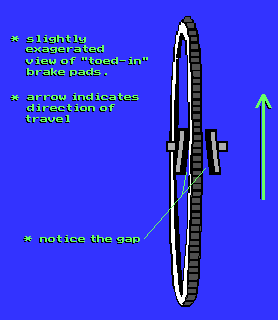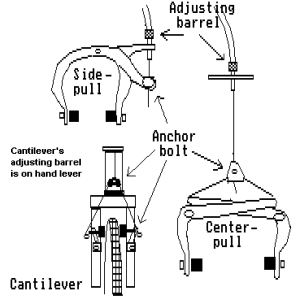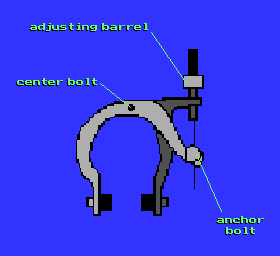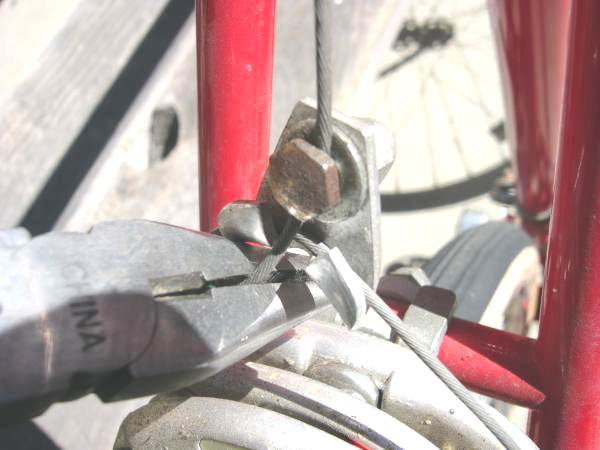"Save Big With Bicycle Discount Coupon Codes"
Bicycle Tune-Up Step 6 - Adjust The Bikes Brakes I
1. Squeeze the bicycle's brake pads against the bikes rim to see if they are at the right height. The bike's brakes should not rub on the tire nor should they be able to slip under the bike rim. (Very dangerous!)
To prevent squeaking, the bike brake pads should also be "toed-in," which means the trailing (front) edge of the pads should touch the bike rim with the brake applied lightly. When you apply the brake hard, the pads squish a little and you should get full contact to the rim. With most steel brakes on older bikes, you carefully bend the caliper arms to get proper toe-in. With the aluminum alloy cantilever bicycle brakes found on most modern road, mountain, and all other bikes, set the toe-in by adjusting and re-tightening the brake pad holder. Do not bend cantilever brakes, or brakes on old Italian bikes because they are made from a more fragile metal or mounted on posts that can be damaged.

Some shimano and other cantilever brakes have springs that can be unhooked while adjusting brake pad alignment and cable tension. Re-hook the springs when done.
2. Look for an adjusting barrel, a long hollow bolt in which the cable housing terminates, but the inner wire goes through. This adjusting barrel may be on the hand lever, or on the brake caliper (the main part of the braking system at the wheel). Screw the barrel all the way in to loosen the cable as much as possible.

Common brake types

Sidepull brake
3. Loosen the holding bolt, pull the cable inner wire tight while squeezing the brake pads together, and re-tighten the holding bolt. The holding bolt may trap the cable inner wire under a plate or washer to secure it, or the holding bolt may have a hold drilled through it to capture the inner wire.

Holding bolts
Sometimes an assistant is helpful for this step. An expert can usually squeeze the brake pads against the rim with one hand while tightening the holding bolt with the other. If you can't manage it, and don't have an assistant handy, a brake inner wire pulling tool is available. This is called a 'third hand tool.' You may not have a third hand tool. In that case, you can generally grab the inner wire with a pair of pliers just past the holding bolt, and twist, pulling the slack out while tightening the holding bolt with your other hand.

The tightness of this bolt is critical. The first mistake most beginning bike mechanics make is to break an holding bolt. Yet, if you don't tighten it enough, when the brake is applied hard in an emergency stop, the cable will slip through the bolt, causing an accident. You must test the bolt by pulling hard on the brake hand lever to be sure the cable does not slip. This test is good for cables too. A weak cable will snap. You'd rather have it snap during the test than when riding!
4. You can fine adjust the brake tension by unscrewing the adjusting barrel a little bit. This effectively shortens the cable.
5. Center the brake if it is too close to one side of the rim. Before this step, make sure the wheel is mounted correctly. Sometimes what appears to be a badly centered brake is simply a wheel fastened in slightly sideways.
If It Is A Sidepull Or Centerpull Brake:
Try loosening the mounting nut (that holds the brake caliper onto the bike), holding the brake caliper centered, then retightening the nut.
If the caliper stubbornly returns to the same position, leave the nut tight, then gently bang on the spring with a punch or dull screwdriver and hammer. The impact will cause the position of the caliper to shift.
If It Is A Cantilever Bike Brake:
Many modern brakes have an adjusting screw on both calipers that applies pressure to the spring. The more you tighten the screw, the further away the brake pad will rest from that side of the rim.
Some Shimano cantilever brakes (and "U-Brakes") have a two millimeter allen screw that you turn to adjust centering.
Some Suntour cantilever brakes have an allen head screw that you can loosen, allowing you to reposition the spring, and then retighten.
If no spring tension adjuster is found, most cantilever brakes have the brake pads mounted on rods so that you can loosen the holders, slide the pads to the proper position and retighten. It is difficult to hold the pad in the proper position while retightening. Patience and perhaps a pair of pliers is required.
Sometimes adjusting the position of the pads is insufficient. Release the cable, then check to see if one of the pivots is stiff or sticking. If so, disassemble, clean with sandpaper, apply grease, and reassemble.
6. Check all the nuts and bolts in the braking system (that you have not already attended to) for tightness.
7. Sidepull brakes often need one more adjustment. The centerbolt has two nuts that work like a bearing adjustment to keep the looseness of the brake properly adjusted. If too tight, the brake will not spring open. If set too loose, the brake will grab or chatter.
Continue To Adjust The Bikes Brakes II
3 Things You Need To KnowBefore You Buy
![]()
Tell a Friend About BikeWebSite
Please feel free to link your web pages to www.bikewebsite.com.
![]()
Copyright © 1991-2014, bikewebsite.com